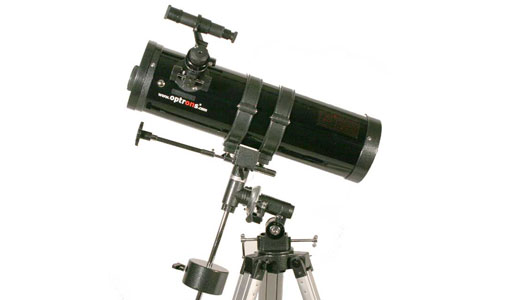Optrons 150/1400 Reflector Telescope
100g butter
100g caster sugar
100g self raising flour
Vanilla essence
Pinch of salt
2 medium eggs
Sponge cake recipe cooking instructions:
1. Preheat oven to Gas mark 190°C2. Mix above ingredients together.
3. Bake...
The Optrons 150/1400 Newtonian reflector is an example of a cheap Chinese telescope purchased from an auction site. Effectively it's a 700 mm tube with a 2X Barlow lens built into the focuser. Compared to the sky watcher EQ1 Mount, this example is particularly flimsy. However, after rebuilding the telescope and with proper collimation, it has now become a passable scope. However, some may find this type of 'device' off putting form the outset and requires a degree of understanding in order to get it to perform adequately, so as a beginners telescope it misses the point.
Compared to the Explorer 150, it gives one an idea of the difference in quality and usability, which is why we added it to our fleet.
Newtonians (also known as catoptrics) usually use a concave parabolic
primary mirror to collect and focus incoming light onto a flat secondary
(diagonal) mirror that in turn reflects the image out of an opening at
the side of the main tube and into the eyepiece. The basic design has been around for hundreds of years and invented by, you guessed it Sir Isaac Newton in 1689.
Advantages
- Lowest cost per inch of aperture compared to refractors and catadioptrics since mirrors can be produced at less cost than lenses in medium to large apertures.
- Reasonably compact and portable up to focal lengths of 1000mm.
- Excellent for faint deep sky objects such as remote galaxies, nebulae and star clusters due to the generally fast focal ratios (f/4 to f/8).
- Reasonably good for lunar and planetary work.
- Good for deep sky astrophotography (not as convenient and more difficult to use than catadioptrics).
- Low in optical aberrations and delivers very bright images.
Disadvantages
- Open optical tube design allows image-upgrading air currents and air contaminants which over a period of time will degrade the mirror coatings and telescope performance.
- More fragile than refractors or catadioptrics and this require more maintenance (such as collimation).
- Suffer from off-axis coma.
- Large apertures (over 8") are bulky, heavy and tend to be more expensive. For portability 150-200mm are best at f/4-f/8.
- Generally not suited for terrestrial applications.
- Slight light loss due to secondary (diagonal) obstruction when compared
with refractors.
In summary a small reflector is the best general purpose telescope for beginners as they are good on all types of objects and for starting astrophotography.
If you wish for the ultimate planetary telescope, and also a scope which is virtually maintenance free then look no further than a refractor.


